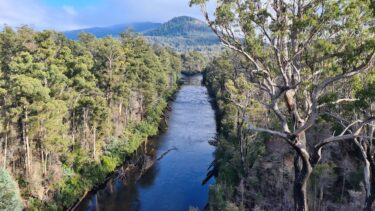Share this article
The interconnected nature of the climate and biodiversity crises are in the spotlight, looking at not only how climate change is a threat to biodiversity, but also what role biodiversity can play to help us mitigate and adapt to a warming climate. Much of the focus has been on decarbonising the economy, however urgent action is also required to halt and reverse the loss of nature this decade to support decarbonisation efforts, protect ecosystems and their services and achieve the promise of the Paris Agreement.
The importance of protecting biodiversity
Australia is a megadiverse country, one of the most biologically rich countries in the world. It is home to between 600,000 and 700,000 species, accounting for 9.6% of all species known to man. The majority of our plant and mammal species and almost half of our bird species are endemic, or unique to Australia. But our biodiversity is under threat like never before. Since European settlement, more than 50 species of Australian animals and over 60 species of Australian plants are known to have become extinct.
This biodiversity plays a critical role in climate and human systems, it is the web of life. It provides the majority of the capital businesses need for the production of goods and services, and ecosystem services humans need to survive. Therefore, a threat to biodiversity is a threat to our way of life.
What are governments doing about biodiversity loss?
At COP27, Paris Agreement champions called on world leaders to secure an ambitious and transformative global biodiversity framework, capable of reversing nature loss this decade, at the COP15 UN Biodiversity Conference in Montreal in December. This will focus on nature-based solutions such as restoring and protecting ecosystems, species, and biological diversity; plus the sustainable and equitable use of ecosystem services by humans around the world.
Australia’s Threatened Species Action Plan
In an effort to conserve and protect Australia’s biodiversity, in 2022 the Government developed The Threatened Species Action Plan 2022-2032, with 4 key objectives:
- The risk of extinction is reduced for all priority species. The plan has increased the priority species list from 100 to 110.
- The condition is improved for all priority places. The plan identifies 20 priority places to target place-based conservation which enables coordinated action for both listed threatened species and other native species.
- New extinctions are prevented.
- At least 30 per cent of Australia’s land mass is protected and conserved.
Both the statement made by the Paris Agreement champions and the Threatened Species Action Plan, identify the importance of a whole society approach. Landholders, communities, First Nations peoples, the private sector, non-government organisations, and regional natural resource management (NRM) groups all need to take action to play a part in conserving and protecting biodiversity in Australia.
Having a robust mechanism for measuring environmental condition and biodiversity is an important tool for accountability and realising nature positive outcomes. With such a mechanism we can monitor progress towards protecting biodiversity and enhancing nature.
The Accounting for Nature Framework (AfN) provides such a mechanism.
Environmental Accounts – a mechanism for measuring environmental condition and biodiversity
The Accounting for Nature Framework has a range of methods suitable for organisations and landholders that wish to create an environmental account. Different methods are suitable for different environmental assets (i.e., vegetation, fauna), project sizes and locations.
The methods have guidance for varying degrees of confidence depending on data collation and management. Further, projects can be self-verified or certified, depending on the objectives and funds of the project owner. In addition, some Methods are free to access and can be used by anyone for measuring the environmental condition of their land or project, but no claims can be made without project registration and certification.
The AfN Framework follows a 5 step process:
- Design
- Register
- Build
- Submit
- Maintain

Environmental Accounts registered under the Accounting for Nature (AfN) framework
A relatively new framework, there are currently 45 registered Environmental Accounts under AfN across Australia, where two have been self-verified and another two have been certified. Of the currently registered projects, project areas range in size from 15 hectares to 5.6 million hectares.
While most projects focus on native vegetation, others also focus on native terrestrial or aquatic fauna, soil and water condition.
Some projects are carbon projects with measured biodiversity co-benefits, others are agricultural regeneration projects owned by farmers and some are small landholder land management projects.
Examples of AfN projects
The Burnett Mary Regional Group (BMRG) has recently obtained certification for their regional-scale (~5.6M ha) Environmental Account. Assets measured in the first stage of this Environmental Account include Native Vegetation and Fauna (with a Freshwater account in progress), with coastal and marine environmental assets to be included at a later date. BMRG will utilise the regional Environmental Account to measure current environmental condition, and over time the change in condition, to inform its natural resource management, investment and funding strategies.
Another example is the Cloverdale Farm Natural Capital Environmental Account which has recently been registered. It is a smaller property at approximately 18 ha. The landowner runs a small-scale cattle and sheep farm using regenerative practices. The landowner intends to use the AfN Framework to track environmental asset condition over time and use it to inform land management practices, enhance ecosystem function and improve biodiversity.
These projects demonstrate a meaningful example of how new frameworks such as Accounting for Nature, with its methods of measuring environmental condition and biodiversity, are an important tool for accountability and realising nature positive outcomes. Coupled with the emerging focus on biodiversity from global leadership and the urgency of governments to finally take action, there is hope that we can halt and reverse the destruction of nature.
Interested in protecting biodiversity and learning more about Environmental Accounting?
We support companies to measure the environmental condition of their natural assets and develop Environmental Accounts or audit their Environmental Accounts for Tier 1 certification under the Accounting for Nature framework. With three Accredited Experts on the AfN Register including two (Category 2) experts and one Auditor we’re here to support your project.

